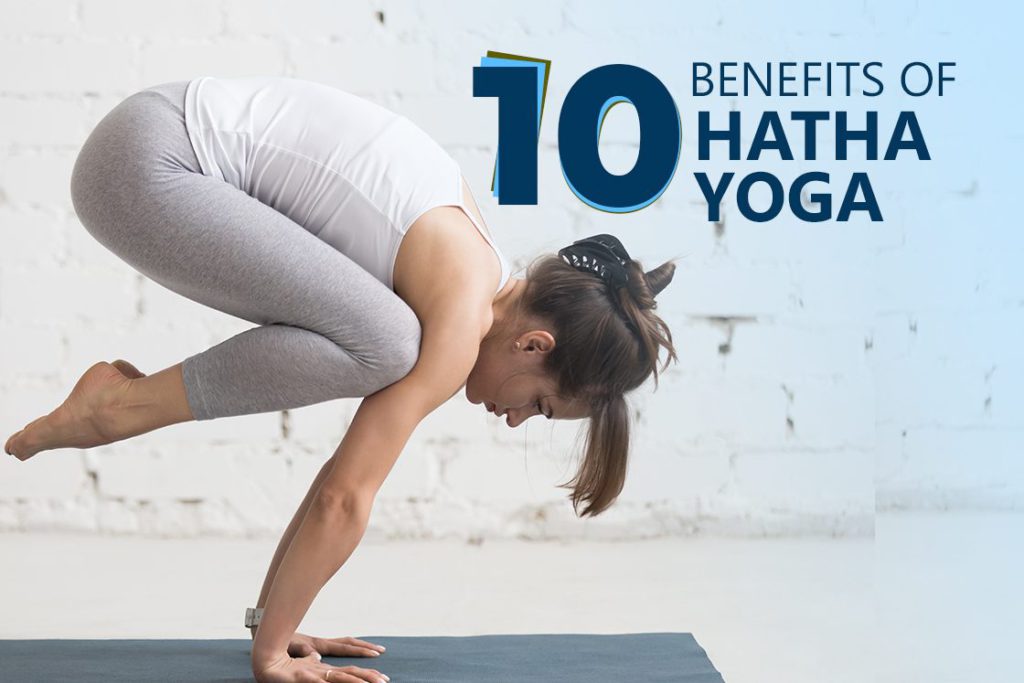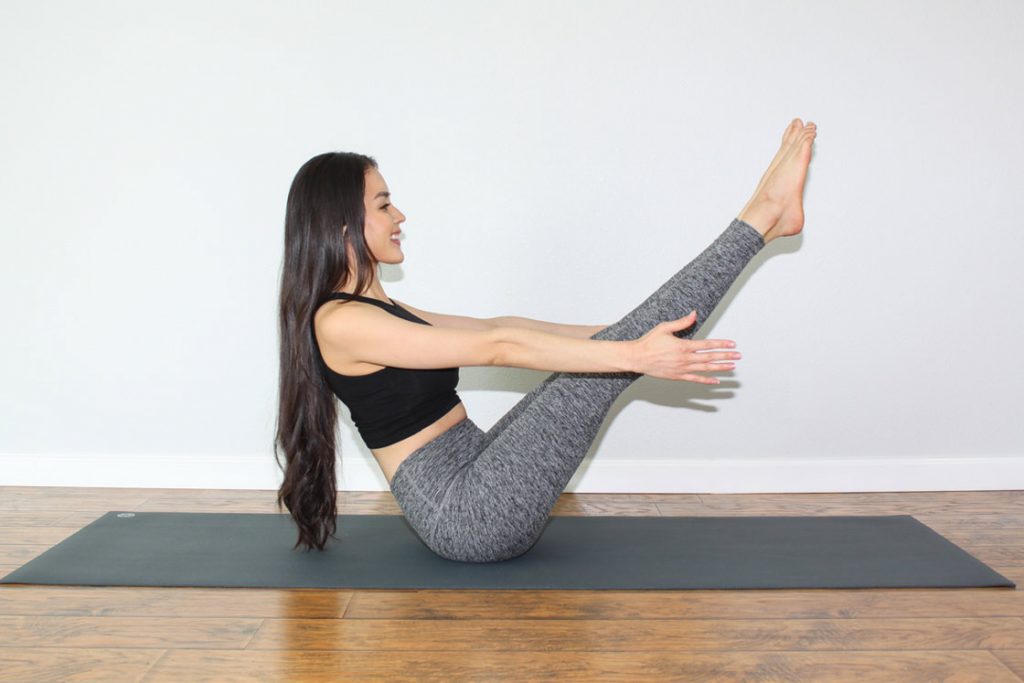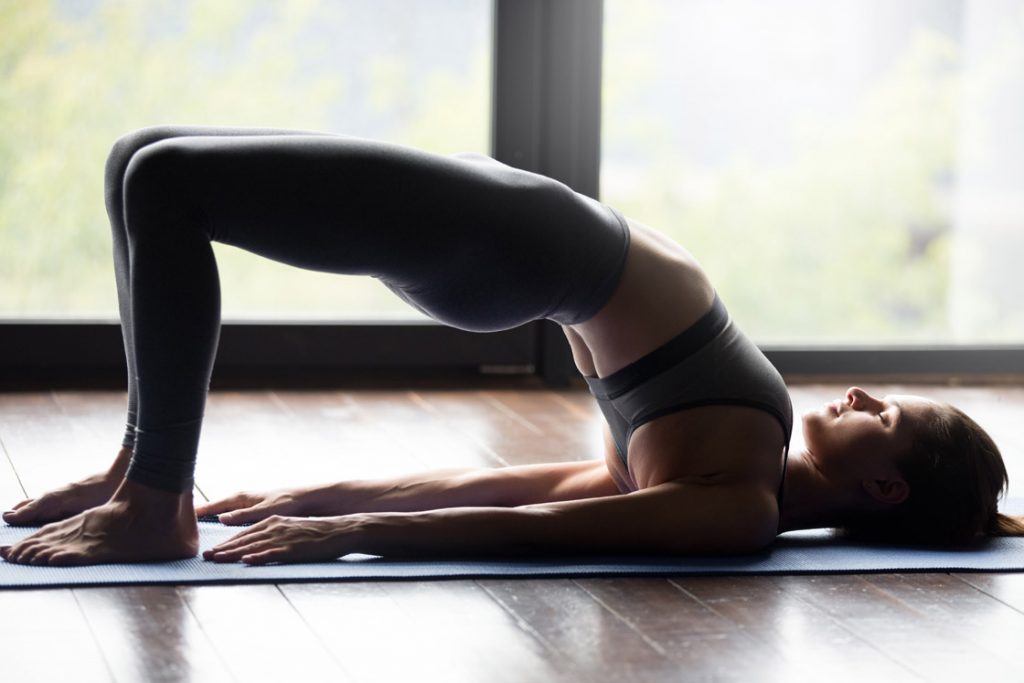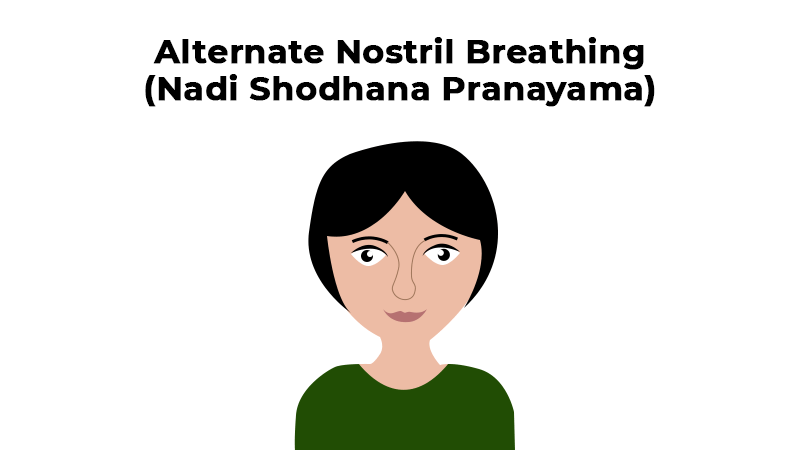- How It Benefits
- Improves Balance
- Strengthen Core
- Improves Immunity
- Healthy Heart
- Strong Bones
- Improves Memory
- Positive Outlook
- Heals Mental Trauma
- Emotional Balance
- Spiritual Benefit

Originally developed as a system of spiritual practices, today hatha yoga has become a mind-body exercise. Not only it enhances strength, flexibility, and balance; the effects of Hatha yoga are even deeper! It has seen in scientific studies hatha yoga reduces the symptoms of stress, anxiety & depression.
The benefits and popularity of Hatha yoga are much as compared to other classical styles because of one simple reason. Hatha yoga is a more practical style where the bodily system is emphasized with great detailing at the beginning. And we know it better, the body is an easy tool to work on as compared to the mind. Hence, the Hatha style is an easy-to-follow and get-result practice, even for a newbie in yoga.
Before jumping into benefits, let’s see the mechanism of hatha yoga how it affects the body and mind!
How Hatha Yoga Benefits Body?
When performing hatha yoga, the main focus is given on holding a pose for a longer duration. This way a pose brings isometric contraction in affected muscles. Putting simply, hatha yoga poses can be considered a type of static isometric exercise that involves muscle engagement without movement.
Holding a Hatha pose keeps muscles under contraction which imparts strength to the affected body areas. It’s great for physical strength, flexibility, and relieving muscle tension.
Another reason for the effective function of hatha yoga is that it maintains the homeostasis of the body. It means on practicing hatha yoga, your body doesn’t produce extra heat so the internal bodily system keeps on working in its natural cycle. It’s evident, certain enzymes optimally function only when the body’s temperature is around 37 degrees.
On practicing hatha yoga the body’s food consumption demand does not directly impact. Unlike other aerobic exercises like swimming, running, or cycling, hatha yoga isn’t that the more workout you do the more bodily demand will increase. It keeps balance bodily energy while maintaining the structural formation of the body. Moreover, food demand doesn’t increase on hatha workout which can lead to gain extra weight.
Hatha Yoga & The Mind
However, the poses can be seen as an action happening on a physical plane but going deep down it’s seen connected to the mind.
In hatha yoga poses, various muscles when comes under contraction, their counterparts get elongated simultaneously. The action of contraction & expansion in muscle fibers activates corresponding nerve impulses located in the cortex and hypothalamus of the brain. This way it exercises the autonomic nervous system; keeping sympathetic and parasympathetic nervous systems balanced.
However, hatha yoga is said to stimulate the parasympathetic nervous system (PNS) which usually dominates in a calming state of mind. In the state of PNS dominance, we are able to balance the heart and breath rate, and eventually, the mind lowers blood pressure and metabolism.
Physical Health Benefits

Hatha yoga mainly comprises 5 types of physical practices; Asana (poses), Shatkarma (cleansing techniques), Pranayama (Breathing exercises), Mudras & Bandhas (gestures & bodily locks).
According to scientific studies, these physical practices of hatha yoga benefit your health in a variety of different ways. Let’s look at seven of these benefits in more detail.
1. Improves Balance and Body Posture
Some balancing hatha yoga poses like side plank and warrior I stretch your wrist while strengthening arms, stomach, and legs muscles. This stretching improves body posture by balancing spine alignment along the neutral axis.
Balancing Hatha postures involve our entire body to work together, hence they help build stable knees, ankles, hips, and shoulders. It also helps in improving reaction time while you tend to slip or fall thereby strengthening the entire body balance.
A wrong body posture can lead to serious health issues like back pain, cardiovascular issues, and digestion issues. Sitting in a passive posture may lead to weaker and tighter muscles.
To evaluate the effect of Hatha Yoga Asanas on improving body postures and balance;
A 2013 study demonstrates hatha yoga enables a range of appreciable joint angles and muscle activities about the ankle, knee, and hip. Moreover, all hatha postures show rectus abdominis activity—an activity requiring continuous dynamic control of the trunk. It helps improves body posture and balance.
Some hatha yoga poses used in this study to improve body posture and balance are Chair pose, Tree pose, Down dog pose, Warrior I, II, III,
2. Strengthen Core Muscles

Performing some hatha yoga poses like Boat pose and chair pose help build the strength of core muscles. Core muscles used in daily routine activities like bending forward, sitting upright, running, and performing athletic activities.
While performing Boat Pose the legs remain in a raised straight posture, which helps strengthen your abdomen and hip muscles. Regular practice of this pose also keeps your spine straight and strong. The internal core organs like kidneys and intestines get stimulated with this posture.
To assess the efficacy of Hatha yoga on strengthening the core muscles; A 2016 study of training in Isha Hatha yoga showed significant improvements in core strength and balance.
The training consisted of Isha Hatha yoga, including Upa yoga, Surya Kriya, Angamardhana, Bhuta Suddhi, and asanas. Significant increases occurred in core stability and standing balance when individuals tested using the single-leg stork test and the plank test at the end of the 21 days training period.
3. Helps Improves Immunity
Yoga poses like Tadasana (mountain pose) and Chaturanga Dandasana (low plank pose) help improve the strong immune system.
A person having a strong immune system can keep himself safe from external viral attacks and other contagious diseases. A strong immune system also helps a human being to get rid of gastrointestinal problems, thereby releasing stress and anxiety.
When we feel stressed, the deep tissue that surrounds our organs, muscles, bones, and ligaments gets affected. A ligament is made up of nerves; hence we need to move and stretch our body so that it remains active. Whatever we eat, it gets absorbed in the body. By performing certain yoga poses, we can release the stagnant energy within our cells so that the harmful toxins in our bodies get removed.
Some hatha yoga asanas and Pranayama increase the oxygen flow into our blood which facilitates fresh circulation. This circulation process helps build a stronger immunity inside our body that keeps us safe from all diseases and stress.
In order to assess the effectiveness of hatha yoga on boosting the immune system, a study was conducted on 18 HIV affected adolescent children. In this study, they were allowed to perform certain yoga asanas like Padmasana, Vajrasana, Sarvangasana, Bhujangasana, Ardhakati chakrasana, Ustrasana, Ardha Chakrasana, Paschimottanasana, and Shavasana. Also some pranayama like Kapalbhati, Bhastrika, Nadishodhana, and Bhramari.
The findings suggested that a six months yoga program has boosted the immunity level of these children and also reduced stress components. The study further revealed that it mentally prepared these children to think in a more positive way.
4. Maintains Healthy Heart

You can be blessed with a healthy heart if you practice certain Hatha Yoga poses like Setu Bandhasana (bridge pose) and Trikonasana (triangle pose) regularly.
The heart is the central organ of your circulation system that pumps the blood around your body. This blood transports all the nutrients and oxygen to all parts of your body and carries away the toxic carbon dioxide out of your body as you exhale. A healthy heart leads to a healthy life.
Performing hatha yoga poses and breathing exercises (pranayama) helps lower the blood sugar level and increase the lung capacity, which therefore aids in a healthy heart. If you perform yoga poses regularly, then it improves heart rate and boosts blood circulation in a great way. Our metabolism also gets improved which helps to get rid of excess fat stored under our skin.
To evaluate the usefulness of Hatha Yoga Asanas on improving the health of the heart a research was conducted in Kaiser Permanente, Northern California (KPNC) population. The researcher took 14 patients (7 male and 7 female) who had undergone cognitive heart diagnosis, as subjects. The participants received 1-hour Hatha yoga classes for 8 weeks, 2x/week (total 16 classes).
The study demonstrates that it’s feasible for patients with congestive heart failure to incorporate hatha yoga into their lifestyle. Yoga may help with routine disease management, prevention of fluid retention, and improvement of depression and quality of life. Patients said to have a more relaxed approach and a calm mind with every yoga session they attended.
5. Builds Strong Bones
Hatha yoga incorporates holding yourself in a certain yoga pose for a few moments. Poses like warrior pose, crescent pose, plank pose, and mountain pose help build stronger bones.
Indeed, when you hold yourself for a certain yoga pose, you restrict a group of muscles against another; this opposition creates a force that stimulates the bone making cells called osteoblasts. They turn into osteocytes which get embedded in your bone. Besides this yoga can reverse the hormonal effects of age thereby leading us to have a healthy bone structure.
In a 2009 study, 10 minutes of yoga daily showed an increased percentage of bone density in the spine and hip among osteoporosis patients. In fact, the hip bone density increased 54% more than the spine density.
Some hatha yoga poses to increase bone density (used in this study) are; triangle pose, downward dog pose, bridge pose, Marichyasana, Matsyendrasana, and Jathara Parivartanasana.
Mental Health Benefits

One simple type of pranayama in hatha yoga called alternate nostril breathing has a very profound effect on mental health. Regular practice of hatha yoga manage and prevent mental health issues such as mood swings, dejection, frustration, and depression.
Here we have discussed a few mental benefits of Hatha Yoga that can be achieved with regular practice.
6. Improves Memory and Concentration
Meditation is a vital part of hatha yoga. It helps improves memory and concentration as doing meditation on a regular basis boosts the growth of neurons. Its related practices are explained in the end chapter of hatha yoga pradipika.
To assess whether meditation has a positive impact on boosting memory and concentration, a study was done on randomized subjects (ages of 18–45) who were non-experienced meditators. They were asked to do a 13-minutes daily guided meditation session or a 13-minutes daily podcast listening session (control group) for a total duration of 8 weeks.
Findings revealed that daily meditation decreased negative mood state and enhanced attention, working memory, and recognition memory as well as decreased state of anxiety.
7. Build Positive Outlook
Hatha yoga balances the positive and negative energies of the body. Thereby it enables us to think in a more balanced way. Hence our suffering gets alleviated and calmness of mind gets restored. You seem to develop a positive attitude when you feel good and happy within yourself.
8. Heals Mental Trauma
Yoga can help us to get over any traumatic experiences that hinder our mental growth and progress. You can perform a few yoga poses like Balasana (Child Pose) and Adho Mukha Svanasana (downward-facing dog pose) that will help increase the blood flow into our cells thereby calming down our nerves and relieving tensions and stress. Breathing exercises also teach you to gain control over your emotions by triggering many psychological mechanisms of your body; hence paving the way to get out of any mental trauma.
A psychotherapy program in a community setting for female survivors of intimate partner violence has been conducted to find out the effects of Yoga on mental health. A 12-week program consisting of 90 minutes of group psychotherapy followed by 30 minutes to 40 minutes of yoga was conducted.
The results indicated that yoga is an adjunct treatment to group psychotherapy for survivors of intimate partner violence. They had few positive experiences that included spiritual healing, increased self-confidence, increased mind-body connection.
9. Cultivate Emotional Balance
Hatha Yoga does not confine itself to only physical exercises, rather it also emphasizes Meditation and Pranayama. Regular practice of all these has a proven experience of achieving a healthy body. If you stay healthy then you become physically strong to absorb the emotional pressure that arises in day-to-day life. Hence our emotions remain in a state of equilibrium with all these practices.
Spiritual Benefits of Hatha Yoga
The initial and traditional purpose of Hatha Yoga was spiritual purification of body and mind, which later on extended its benefits in healing physical and mental illness.
Performing Hatha Yoga with various Asanas, Bandhas, Pranayama, and Dhyana (meditation) purifies our mind and soul. It awakens the energy channels and energy centers within our body, which is called Kundalini awakening. Kundalini is the force energy that remains coiled at the spine after the awakening.
Moreover doing deep meditations develops a spiritual awakening and a sense of completeness within us. We feel close to the divine while sitting in a meditative pose with certain mudras.





Great article. Thank you for describing the multi-faceted benefits of Hatha Yoga for this newbie.
Thanks for sharing the great post with us. I think Hatha Yoga is actually one of the life-transforming exercises that should be adopted. I am enjoying my time with the help of your Blog. Thanks again for sharing a more informative and amazing blog. Best of luck to you!